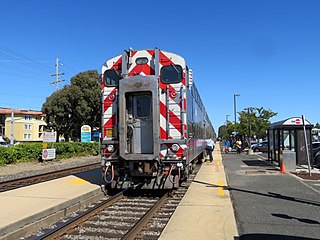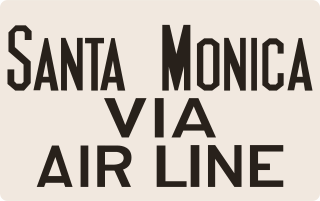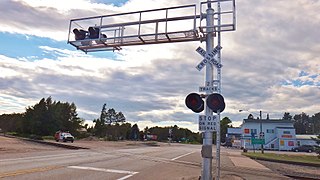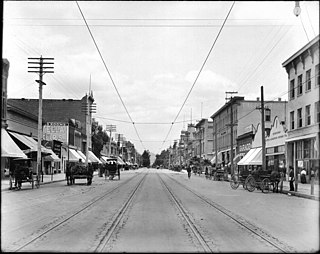Related Research Articles

A level crossing is an intersection where a railway line crosses a road or path, or in rare situations an airport runway, at the same level, as opposed to the railway line crossing over or under using an overpass or tunnel. The term also applies when a light rail line with separate right-of-way or reserved track crosses a road in the same fashion. Other names include railway level crossing, railway crossing, railroad crossing, grade crossing, road through railroad, criss-cross, train crossing, and RXR (abbreviated).

The Pacific Electric Railway Company, nicknamed the Red Cars, was a privately owned mass transit system in Southern California consisting of electrically powered streetcars, interurban cars, and buses and was the largest electric railway system in the world in the 1920s. Organized around the city centers of Los Angeles and San Bernardino, it connected cities in Los Angeles County, Orange County, San Bernardino County and Riverside County.

Wigwag is the nickname given to a type of railroad grade crossing signal once common in North America, named for the pendulum-like motion it used to signal the approach of a train. It is generally credited to Albert Hunt, a mechanical engineer at Southern California's Pacific Electric (PE) interurban streetcar railroad, who invented it in 1909 for safer railroad grade crossings. The term should not be confused with its usage in Britain, where wigwag is generally used to refer to alternate flashing lights, such as those found at modern level crossings.

The Atchison, Topeka and Santa Fe Railway, often referred to as the Santa Fe or AT&SF, was one of the larger railroads in the United States. The railroad was chartered in February, 1859 to serve the cities of Atchison and Topeka, Kansas, and Santa Fe, New Mexico. The railroad reached the Kansas–Colorado border in 1873 and Pueblo, Colorado in 1876. To create a demand for its services, the railroad set-up real estate offices and sold farmland from the land grants that it was awarded by Congress.

A bank engine, banking engine, helper engine or pusher engine is a railway locomotive that temporarily assists a train that requires additional power or traction to climb a gradient. Helpers/bankers are most commonly found in mountain divisions, where the ruling grade may demand the use of substantially greater motive power than that required for other grades within the division.

The Alameda Corridor is a 20-mile (32 km) freight rail "expressway" owned by the Alameda Corridor Transportation Authority that connects the national rail system near downtown Los Angeles, California, to the ports of Los Angeles and Long Beach, running below Alameda Street. The corridor is considered one of the region's largest transportation projects when it was constructed.
The Magnetic Signal Company was an American company based in Los Angeles, California focused on railway signalling. The company was the manufacturer of the ubiquitous "Magnetic Flagman" wigwag railroad crossing signal seen all over California and the western states.

The Illinois Railway Museum is the largest railroad museum in the United States. It is located in the Chicagoland metropolitan area at 7000 Olson Road in Union, Illinois, 55 miles (89 km) northwest of downtown Chicago.

The Griswold Signal Company was an American company focused on railway signalling, based in Minneapolis, Minnesota. Founded by Minnesota native Franklin Wolcott Griswold, the company manufactured traffic signals and railroad level crossing signals.
Wigwag, wig wag, or wig-wag may refer to:

Broadway is a Caltrain station in Burlingame, California. Caltrain only serves the stop on weekends and holidays; weekday service is provided by a bus shuttle to Millbrae.

Glendale–Burbank is a defunct Pacific Electric railway line that was operational from 1902 to 1955 in Southern California, running from Downtown Los Angeles to Burbank via Glendale. Short lines terminated Downtown and in North Glendale, including the popular Edendale Local.

The Santa Monica Air Line was an interurban railroad operated by the Pacific Electric between Santa Monica and downtown Los Angeles. It operated between 1909 and 1953. Most of the route is now used by the Metro E Line.

The Whittier Line was a Pacific Electric interurban line which traveled between Los Angeles and Whittier via Huntington Park, Rivera, and Los Nietos. Due to its indirect route, the line was eventually replaced by bus service on Whittier Boulevard.

The Long Beach Line was a major interurban railway operated by the Pacific Electric Railway between Los Angeles and Long Beach, California via Florence, Watts, and Compton. Service began in 1902 and lasted until 1961, the last line of the system to be replaced by buses. However, the Southern Pacific Transportation Company continued to operate freight on the tracks, as the Union Pacific Railroad still does north of Dominguez Junction, and in 1990 the Southern California Rapid Transit District opened the Blue Line light rail along the same right-of-way.

Level crossing signals are the electronic warning devices for road vehicles at railroad level crossings.

The Southern California Railway Museum, formerly known as the Orange Empire Railway Museum, is a railroad museum in Perris, California, United States. It was founded in 1956 at Griffith Park in Los Angeles, before moving to the former Pinacate Station as the "Orange Empire Trolley Museum", in 1958. It was renamed "Orange Empire Railway Museum" in 1975 after merging with a museum then known as the California Southern Railroad Museum, and adopted its current name in 2019. The museum also operates a heritage railroad on the museum grounds.

The San Bernardino–Riverside is a former Pacific Electric (PE) interurban railway line in the Inland Empire. Unlike most of the company's services, trains did not travel to Downtown Los Angeles and instead provided a suburban service between San Bernardino and Riverside.
The Venice–Inglewood Line is a former Pacific Electric interurban railway line in Los Angeles County, California. Service was very sparse, providing a suburban service between Venice and Inglewood.
References
- ↑ DelVecchio, Rick (January 26, 2002). "Wigwag War / Point Richmond residents fight to save artifacts from the low-tech era". San Francisco Chronicle. Retrieved April 4, 2021.
- ↑ Florence, S.R. (July 10, 1929). "Conceived and Developed Wig-Wags" (PDF). Pacific Electric Magazine (Vol. 14 No. 2). p. 6. Retrieved April 4, 2021.